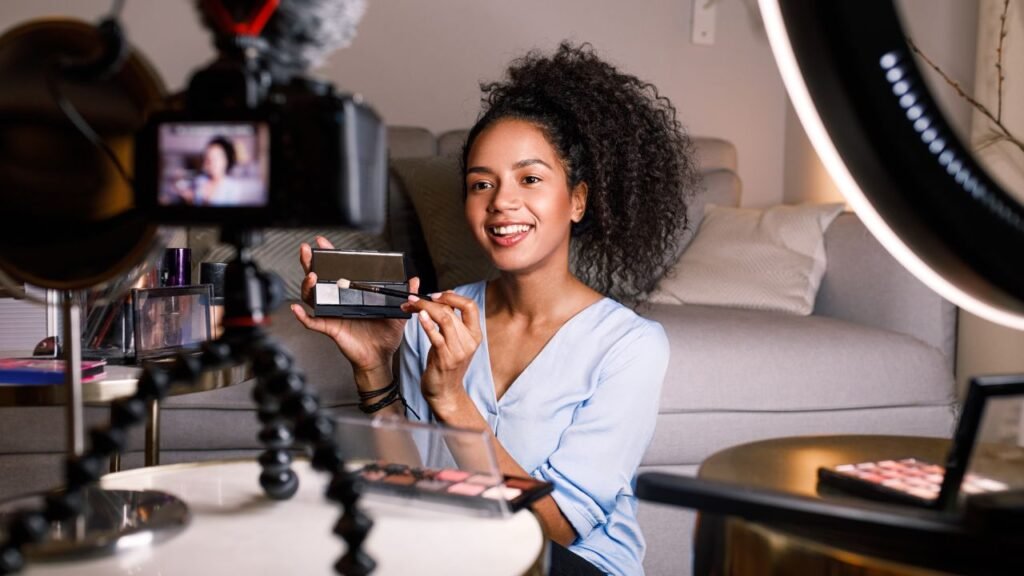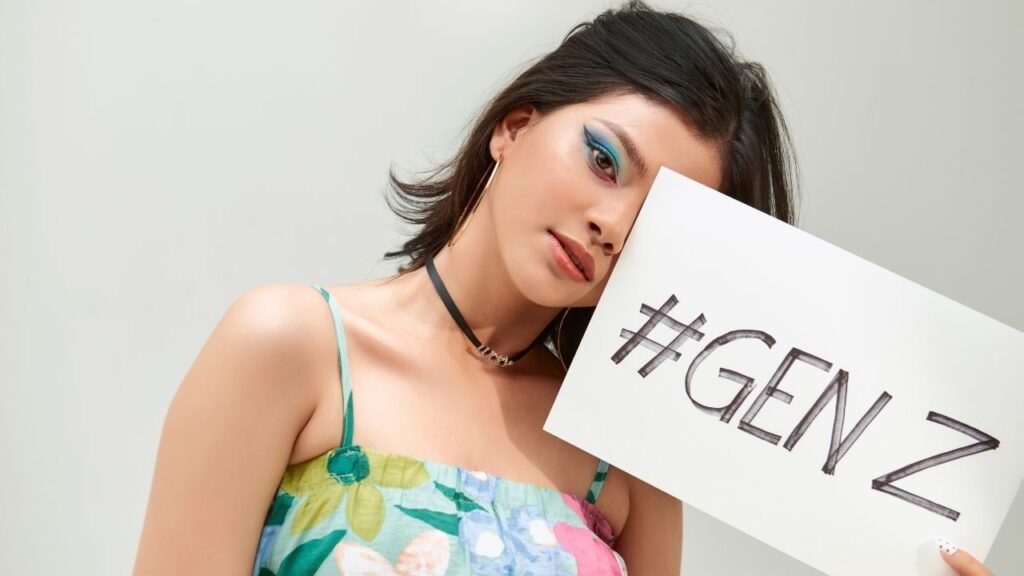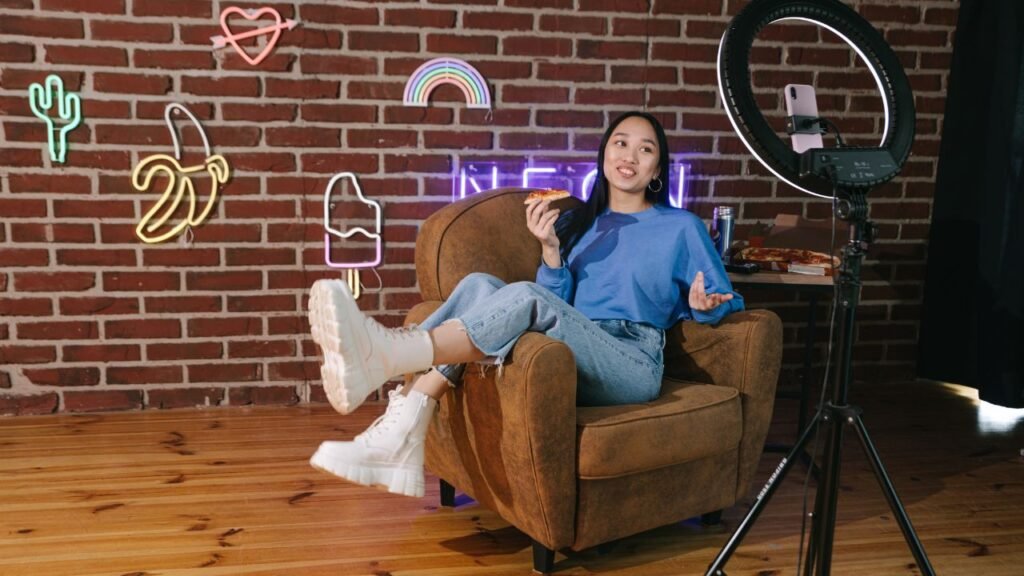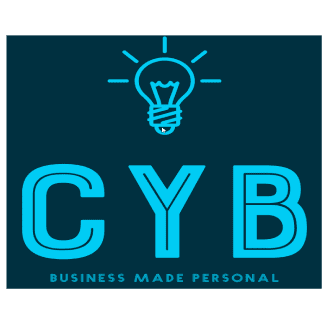Do you ever go on TikTok and come across some influencer doing a try-on haul from GymShark? Or maybe you tried the Travis Scott meal from McDonald’s when it came out because you love Travis and his music? Well, hate to break it to you but you’ve been influenced.
Influencer marketing became all the rage after the pandemic with people with a handful of followers starting to review products and give their thoughts on it. And once Instagram became the new Facebook, this marketing tactic really flew off. So, what’s all the craze about and why are brands jumping on the bandwagon? Let’s find out with a bunch of stats to back it up!
What is Influencer Marketing?
Influencer marketing is like teaming up with someone popular on social media to tell others about your stuff. These popular people, called influencers, share cool pictures or videos using your products, and their followers pay attention because they trust them. It’s like having a friend recommend something to you.

How It Works:
The influencer makes fun posts or videos using what you’re selling, and their fans see it. People like and comment on these posts, creating a buzz. Because the influencer is already liked and trusted, their followers are more likely to check out and buy what’s being shown.
Why It’s Works:
- More People Know About You:
You get to reach a bunch of new people because the influencer has a big fan club.
- Feels Real:
When an influencer talks about your product, it feels genuine and not like a boring ad.
- All Kinds of People:
Influencers have followers from different places and backgrounds, so you connect with a diverse bunch of potential customers.
Influencer Marketing Statistics and What They Mean for You
Let’s take a look at some of the most eye-opening stats on influencer marketing for 2024:
Influencer Marketing Growth
Did you know that over 25% of marketers have embraced influencer marketing as part of their strategy? According to forecasts, the influencer marketing industry is on an impressive growth trajectory, with a projected compound annual growth rate of 33.4% until 2030.
Let’s look at the numbers: Back in 2016, the industry was valued at $1.7 billion USD. Fast forward to 2022, and it skyrocketed with an average annual growth rate of 46.9%, reaching a substantial $16.4 billion USD. Projections indicate that by 2023, we’re looking at a value of $21.2 billion USD.
The influencer marketing landscape has taken a big leap, going from just over 10,000 worldwide influencers in 2019 to a staggering 18,900 in 2021, as per insights from a Market Analysis Report (source).
Key Takeaway
Here’s the scoop: Influencer marketing is blowing up! From a small $1.7 billion to a massive $16.4 billion in just six years. It’s not just a passing trend; it’s becoming a big deal for brands. More marketers are jumping on board because it’s a powerful way to connect with us—the audience.
Instagram is taking the lead for better ROI
Let’s talk about social media and business. According to a survey by CreatorIQ, Instagram is a standout platform for brands. In the survey, a whopping 62% of organizations chose Instagram as the most crucial social media platform for their influencer marketing programs. That’s like saying, “Hey, Instagram, you’re our go-to!”
Now, here’s where it gets interesting. Of those surveyed, 60% reported that Instagram gives them the most Return on Investment (ROI). ROI is like the money you make back from what you spend on ads. So, for every dollar spent on influencer marketing on Instagram, they get double in return compared to other social media platforms. That’s a pretty sweet deal for businesses.
But, looking ahead, the survey also highlighted that TikTok and YouTube are making waves. In fact, when asked about upcoming trends in 2024, TikTok and YouTube took the spotlight. 28% of brands and agencies said TikTok was their primary platform for influencer marketing.
Key Takeaway
Instagram is the reigning champion, for now, delivering a solid ROI for brands. However, keep an eye on TikTok and YouTube—they’re gaining momentum and are expected to be significant players in the influencer marketing game in the near future.
Nano Influencers are Influencing the Most
Okay, check this out: The number of followers an influencer has is important, but what’s even more crucial is how much their followers engage—like, comment, and share their stuff.
Here’s the scoop: 35% of marketers say that people tend to trust smaller influencers more. Now, there are these tiny influencers called nano-influencers, with less than 5,000 followers. Surprise, surprise! They have the highest engagement rates at 2.53%. It’s like the more followers you have, the less people interact, especially when you’re a celebrity-level influencer.
Key Takeaway
In a nutshell, it’s not just about having tons of followers. Smaller influencers, known as nano-influencers, score big when it comes to engaging their audience. People trust them more, and their engagement rates are sky-high compared to the big shots. This data is from HypeAuditor, and it’s a heads-up for marketers: sometimes, smaller is mightier!
Brands want to Spend Money on Influencer Marketing
Here’s a little eye-opener: 17% of companies are going all-in with influencer marketing. Like, they’re spending more than half of their entire marketing budget on it this year. That’s a decent chunk!
Key Takeaway
So, what’s the deal? Well, for some companies—especially those in e-commerce, fashion, beauty, gaming, travel, and lifestyle—working with influencers is a big deal. They’re putting serious money into it, showing just how crucial influencers have become in their marketing strategies.
Gen Z is getting the MOST ‘Influenced’
Let’s talk target audience and influencers. If your audience includes Generation Z, those young people aged 16 to 23, you’ve got a real advantage. Recent data spills the beans that a whopping 85% of Gen Z shoppers say social media, especially influencers, guides what they decide to buy. These influencers aren’t just random faces; they’re the main way Gen Z discovers new products.
Now, the plot thickens when your audience is a bit older. It turns out, older consumers are less into following influencers on social media. Only 9% of baby boomers are on the influencer-following train, while nearly half of Gen Z is on board.

Key Takeaway
Here’s the deal: Know your audience. If it’s the Gen Z crew, influencers are your secret weapon. These influencers are shaping what these youngsters think and like, so you know what to target. But if you’re dealing with an older crowd, well, then you might want to rethink your influencer strategy. It’s no secret that baby boomers and boomers have been ruling Facebook for a while now, and they are ready to leave it just yet. So make sure to use influencer marketing where it will work otherwise you will end up wasting a lot of money!
AI has not left Influencer Marketing Alone
AI has literally not left anything alone, and influencer marketing is no exception. More and more brands are stepping up their game by using AI and automation. What does this mean? Well, according to recent data, a solid 63% of brands are planning to use AI in their influencer campaigns. You might be thinking, how will they even use it? Well, brands are using it to identify the right influencers, create engaging content, and personalize everything they do for their customers. Apparently, AI is the way to the hearts of customers who you want to make loyal.
Key Takeaway
AI creates content that attracts and converts. It also helps your marketing team to tweak the marketing campaign so it’s always a hit(no misses here). And you know what else AI does? It can spot those fake influencers or engagements that try to sneak in. AI might just be the future of influencer marketing(like everything else)!
How Much are Instagram Influencers Charging?
Instagram influencers are charging some pretty decent amounts for these posts and marketing.
- Nano-influencers (with less than 10,000 followers), charge around $20 to $100 per post.
- Micro-influencers (with 10,000 to 50,000 followers) go for $35 to $450.
- Mid-influencers (50,000 to 500,000 followers) charge $150 to $2,500.
- Macro-influencers (500,000 to 1 million followers), ask for $250 to $7,000.
And if you’re dealing with mega or celebrity influencers (1 million or more followers), hold on tight—they start at $1,200 and go way up. Don’t worry, you won’t need the help of these mega celebrities when nano-influencers can do the job!
Key Takeaway
It’s actually pretty straightforward. The price of an Instagram post depends on how famous the influencer is. Smaller ones are more budget-friendly, while the big shots like James Charles, Kylie Jenner, and Addison Rae might end up costing your entire business. So choose wisely.
Facebook is the Turtle of the Race
Facebook used to be a major player in social media, but lately, it’s been changing its game. The organic reach—the number of followers who see a business’s regular posts without getting paid for it—has been going down because of their move to a pay-to-play model.
Now, in terms of influencer marketing, fewer brands are relying on Facebook. Currently, only 57% of marketers are using Facebook for their influencer marketing efforts. TikTok is gaining ground at 61%, and Instagram takes the lead with 72%.
Key Takeaway
So, what’s causing this shift? Well, Facebook is not as go-to as it once was for influencer marketing. However, for e-commerce brands, Facebook still brings something to the table. You can team up with influencers for live streams, market their product, or create eye-catching Stories that pop up in people’s feeds.
Facebook is still struggling a little to compete with other social media giants but it’s not backing down yet.
Using Celebrities for Marketing will cost an arm and a leg
Now you should hold on tight for this one. When celebrities post a product, they are paid a very handsome amount for it. Like, we’re talking beyond $1 million for just one post! That’s the price of having more than a million followers.
Key Takeaway
If you’re a celebrity with a massive following, you’re in the big leagues. Estimates from research are opening our eyes – celebs charge $10,000 or more for an Instagram video, $20,000+ for a YouTube video, $2,500+ for a TikTok video, $2,000 for a Twitter post, and a whopping $25,000 for a Facebook post. That is unbelievable!
And get this, stars like Cristiano Ronaldo are reportedly demanding a jaw-dropping $2.3 million for one post, while Kylie Jenner isn’t far behind, asking for $1.8 million.
Oh and if you’re thinking about teaming up with an influencer, here’s a heads-up for you. Many influencers work with managing teams. It’s not just a one-on-one thing. To confirm a sponsorship, you might need to reach out to the influencer’s managing team. Easy way to find out? Check their bio—it usually has details on who to contact for sponsored content opportunities.
Big Bucks are coming in for Businesses
Businesses are making a significant return on investment from influencer marketing. According to a survey, for every dollar spent, they’re raking in $5.78. Let’s break it down: If you invest $2,000 a month in influencer collaborations, you could potentially see over $11,500 in orders, assuming you partner with the right influencers.
Key Takeaway
Take a look at your other marketing channels. Are they delivering comparable results? If not, it might be time for a budget rethink. Consider shifting some funds from your lower-performing channels and directing them toward influencer marketing. It’s a move that could boost your overall marketing ROI. The data speaks for itself—sometimes, the most rewarding investment is the one made with influencers.
Measuring ROI can be a Challenge
When it comes to influencer marketing, the biggest challenge for over 60% of marketers is monitoring the return on investment (ROI). Why? Well, not every person who sees your influencer’s sponsored post will rush to buy. Some might check it out, visit your website, and then make a purchase weeks later when they remember your product’s solution.
This challenge outweighs other concerns like selecting the right influencers (55.86%), ensuring content quality (52.25%), and maintaining brand safety (49.55%). It’s all about tracking the impact of influencer efforts, and that can be a bit tricky.
Key Takeaway
The difficulty isn’t just in picking the right influencers or ensuring quality content; it’s in figuring out how well your influencer marketing is really working. With the delay between exposure and purchase, monitoring ROI becomes the key puzzle for many marketers. So be patient and precise.
Brands are willing to spend on Influencer Marketing
Get ready for a shift: Brands are doubling down on influencer marketing. According to a survey by IMH, a whopping 67% of respondents are planning to increase their budget for influencer marketing in the next 12 months. This surge indicates a strong trend of brands recognizing and investing more in the value of influencer marketing, aiming to maximize their return on investment (ROI).
Now, here’s the breakdown: 15% of respondents plan to stick to their current budget, while 11% are still unsure about their spending plans. Interestingly, only 7% of respondents are thinking about cutting back on their influencer marketing spending.

Key Takeaway
Brands are willing to put money from where money is coming from. Paying influencers is like investing in a product that you know for a fact it will work. Businesses don’t have to worry about ROI with influencer marketing.
31% of New Products Discovered
Did you ever see an influencer use a product that you didn’t even know existed? That’s not chance, it’s actually proven that influencer marketing introduces us to new products. A big 31% of social media users prefer learning about new products through influencers they follow. So if your brand is coming up with a service or product that you think is new, then influencer marketing will help get a fresh audience for it.
Key Takeaway
Influencers are matching products and people together. Whether you’re targeting a broad audience or just want to please Gen Z, influencer marketing is the way to go. Brands are putting their money into influencers because they understand the impact these people have on product discovery.
Wrapping Up
On every single marketing strategy PowerPoint, you will find one page that will mention the list of influencers the brand will use to market. Why? Because brands have finally woken up to the potential of it. If you’re also one of them, then these stats will only make your decision to invest in influencer marketing a confirmed one!


